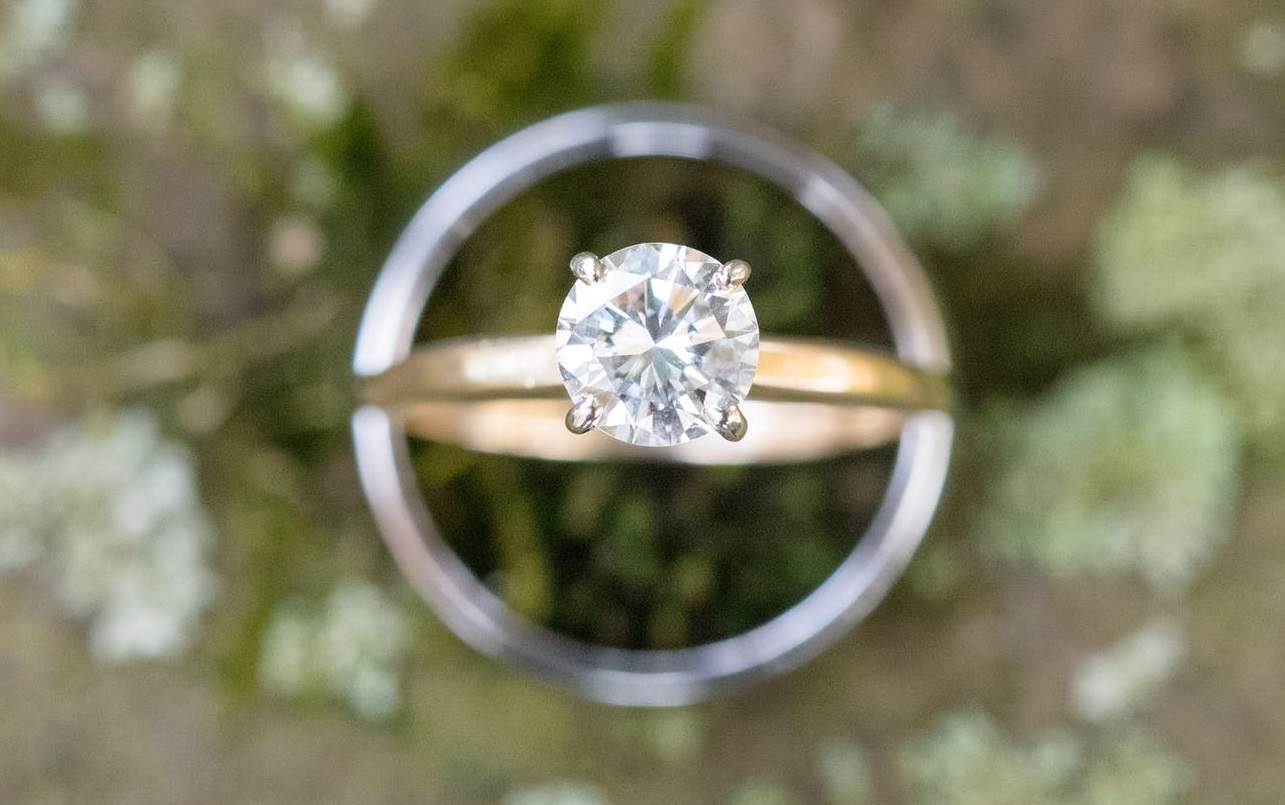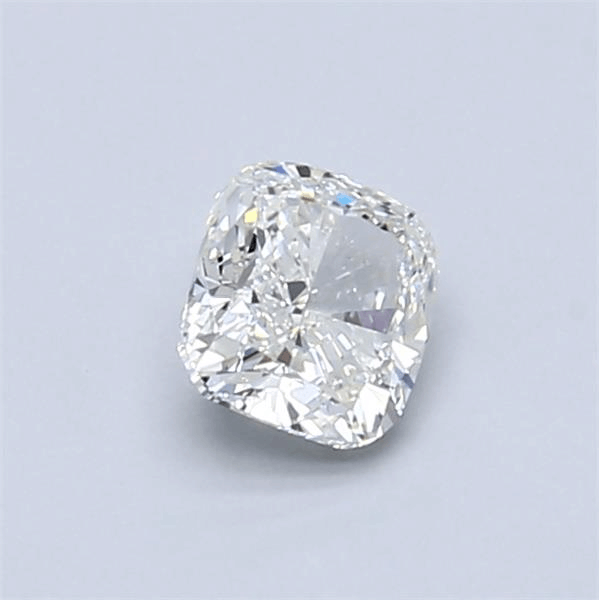
Table of Contents
As Jewelry Shopping Guide editors, we write about things that we love and we think you’ll like too. We often have affiliate partnerships, and may generate some revenue from these links at no cost to you.
Diamond color is one of the most important factors determining a stone’s quality. With color being one of the main 4Cs for diamond quality, together with carat, clarity, and cut, it’s evident that you should choose your future diamond’s color with care.
We’ve already gone through the specifics of diamond colors, so instead let’s focus on one particular color grade that’s often a subject of a lot of dispute – J grade diamonds.
A J color diamond is often viewed as inferior by a lot of vendors, pundits, and industry professionals. And strictly speaking, that’s true – J is below several other color grades on the color scale. But that doesn’t mean that it’s not worth your while nor that it can’t make for a great center diamond.
What Is the Diamond Color Scale and What Are J Diamonds?
The diamond color scale refers to the grades which the GIA (Gemological Institute of America) uses to classify different diamond colors. It’s generally accepted and used across the world as an industry standard.

The scale runs from D to Z in alphabetical order. The highest quality stones are the ones that are as clear as possible – the ones at the beginning of the scale. D, E and F colored diamonds are considered the most valuable colorless diamonds as they are almost perfectly clear.

J diamonds fall into the near colorless category along with G, H and I and J. These stones look colorless when seen face-up (from the diamond’s table) but show a visible color when looked at from the side or in front of a clear background.
Further down the color scale sit K, L and M diamonds which display an even more noticeable color. Stones from M to Z are the lowest valued stones in terms of quality. In fact, stones below M on the scale are very rarely even sold. James Allen sells M colored diamonds but Blue Nile, for example, stops at J colored diamonds.
So, as you can see, J grade diamonds sit at the bottom of the “Near colorless” group of colors. This gives them a special spot on the list and makes them worth talking about because they are simultaneously much cheaper than D – I diamonds but still of a high enough color quality to be considered a good choice in a lot of situations.
Does A J Color Diamond Look Too Yellow?
Whether a diamond is too yellow or not is a subjective matter. What’s too yellow for me might be a wonderful, warm tint for you. There’s nothing wrong with having a diamond that displays yellow tints and in fact, some people specifically choose warm diamonds for their aesthetics.

Compared to a D color diamond, a J color diamond displays a very noticeable yellow tint, especially when viewed from the side or in front of a clear white background. This makes a lot of diamond purist reject J grade diamonds (and even G – I stones) as not worth looking at but we maintain they do have their place in your considerations.
The simple fact of the matter is that despite their slight yellow tint, J color diamonds appear almost colorless when viewed from above and that’s the direction a diamond ring is most viewed from when worn. Additionally, when mounted in the right way, on the right color ring and with the right setting, a J grade diamond can seem near colorless to the naked eye even when glimpsed from the side.
This makes J color diamonds a great choice for people who are not absolute purists when it comes to the 4Cs and are looking for a mix of value and beauty. J diamonds are also ideal for those clever shoppers who also know how the other components of a diamond ring or a piece of jewelry can mask and make up for the slight tint of a J color diamond.
Why You Can Save With A J Diamond
Despite being 2 grades below H color diamonds, J grade diamonds are approximately 25% cheaper than them with all other factors being equal. Take a look at this 0.7 carat J color diamond and this 0.7 carat H color diamond for example. Although they’re in the same color category, the difference in price is considerable. Saving on the diamond’s color means that you can put that money into something else, like upgrading the cut or carat weight or choosing a nicer setting.
J Diamonds and Settings – How the Setting Color Can Affect the Diamond
Lowering the price of a ring is a good enough reason to choose a J color diamond, however, that shouldn’t distract from the fact that you’ll still want your stone of choice to look as good as possible. If you don’t want the yellow hints of the diamond to show, you’ll need to pay attention to your ring setting.
The first significant factor to consider is the metal color of your ring. As that metal will play the role of the background against which you’ll be viewing the diamond, it will determine your perception of the stone as well as the light it reflects back at you.
White gold and platinum tend to make the yellow tint of the J grade stone noticeable. The yellow tints against the reflective white metal tends to show through. Instead, a yellow gold or rose gold metal setting can easily make a J color diamond look more colorless by comparison. This is because our eyes tend to compare the metal and the diamond, and of course the diamond comes out looking whiter.

Take a look at the image above of two similar diamonds set in different colored settings. The yellow tint of the diamond on the right is noticeable while left diamond seems significantly clearer.
Settings to Choose with Care
Aside from the metal of the ring the style of the diamond matters quite a lot as well. This is especially important for diamonds that are placed in a side stone setting or in a halo setting.
For example, having a J color diamond surrounded by a halo of colorless D-G melee diamonds will show up the tints of the center stone. Even if mounted in a yellow gold ring, the higher quality of the halo diamonds will make the yellow tint of the centerpiece much more visible. The opposite would also be a mistake – placing a J diamond within a halo of lower quality melee stones. The beauty of the main diamond will make the lower quality of the halo even more noticeable.
Another factor to consider is whether your chosen ring setting will have side stones. If these stones are colorless, they can show up your center stone’s yellow tints by dint of comparison. Check that these stones are selected to match the center stone’s color and that they’ll complement the J diamond.
How Diamond Shape Affects J Color Diamond
A diamond’s shape is another factor that contributes to our perception of its color. Round brilliant cut diamonds tend to hide color well due to their high number of facets and the intense sparkle they have.
Fancy shapes like marquise, Asscher, radiant and oval aren’t very good at masking color. Princess and cushion, two very popular diamond shapes, aren’t as good as round diamonds in hiding color but are still better than most of the other fancy shapes.
At the end of the day, it’s all about how you like your diamond so don’t get too hung up on the specifics and look for what looks good on you.
The Importance of Fluorescence
This is one frequently ignored factor when it comes to masking the color tints of J grade (or similar) diamonds. It’s also a relatively misunderstood phenomenon by a lot of people.
Diamond fluorescence is a characteristic that’s present in approximately one-third of diamonds. Fluorescent diamonds tend to have a soft glow (usually bluish) when placed underneath ultraviolet light. This effect is caused by the presence of certain minerals inside the diamond.

For D, E, F, and G color diamonds, fluorescence is usually ill-advised as it can give them a hazy bluish look. However, for diamonds lower on the scale such as J color ones, the fluorescence effect can actually improve their color. In these diamonds, the slight bluish fluorescent coloring counteracts their already present yellowish tint and makes the whole stone look clearer.
Choosing a J diamond with fluorescence is a great way to make them seem a grade higher without increasing their price at all.
Brian Gavin have a unique, excellent collection of carefully chosen fluorescent diamonds. Check this Blue Collection here for a great value diamond.
Related Article: BRIAN GAVIN BLUE COLLECTION
To Wrap Up….
While J color diamonds are in the middle of the diamond color scale (or toward its end if you just count the D – M portion of the scale) they do have their uses. Carefully choosing the diamond’s
- Shape
- Fluorescence
- Setting
- Metal color
can give you an excellent piece of jewelry and a stunning center J diamond. Not only will you save with a J diamond but you will still have a stunning ring to boot.
There are quite a few considerations to be accounted for in order to make a J color diamond look its best but when that’s done these diamonds can work quite well.
If you have the extra budget, should you splurge on a colorless ring? That’s entirely up to you. There are some who would still choose a slightly tinted diamond over a colorless stone regardless of budget. Still, if you do have the money to splurge, there’s no reason not to go for a D-F diamond.
Online Stores We Recommend for J Color Diamonds
A diamond is a big purchase and not one to be undertaken lightly. By taking your search online, you’ll be able to access competitive prices and have a wide range of options to source from.
However, it is imperative to choose a trustworthy and reliable vendor, known for the quality of their products and services. We recommend the following retailers when it comes to shopping for a diamond online:
James Allen
James Allen allows you to view each diamond carefully from all angles using their ground-breaking Diamond Display Technology. They also have Diamond Experts on hand to help you through the process.
Blue Nile
Blue Nile has the largest online inventory of diamonds at competitive prices. They’re known for their quality and great customer service.
Brian Gavin
Brian Gavin’s diamonds are famous for their cut quality and for their continuous innovation in perfecting their cut quality. Their Black and Blue Collections feature some of the very best diamonds.
Whiteflash
Whiteflash are known for having some of the best diamonds in the world with innovative cut specifications. If you’re looking for a brilliant stone, you shouldn’t skip Whiteflash.









